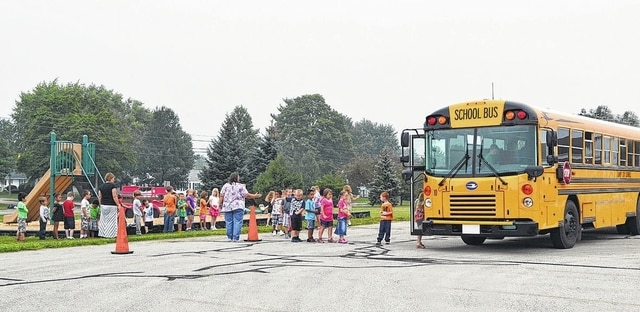
SIDNEY — As teachers and administrators get things in order to start the new academic year, plans for getting students to school safely also come into play.
Eric Finke, director of operations and technology for Sidney City Schools, said drivers and buses are ready to transport youngsters who live two or more miles from their school buildings. This year, there will be 17 bus routes. The district also provides bus service to students attending Lehman and Holy Angels Catholic schools and the Christian Academy.
Finke cautions drivers to be careful as buses take to the roads.
“Follow the traffic rules that everyone was taught in driver’s training,” he said. “Keep a distance behind a bus and when lights are flashing, pay attention.”
Scott Rodeheffer, principal of Fort Loramie Elementary School, plans to fill in himself as adviser to fifth- and sixth-grade school crossing guards, until a teacher can be identified to take over the role vacated by a retiring educator in the spring. Fort Loramie is the only Shelby County school system to participate in the AAA School Safety Patrol Program, according to Deborah Barga, CEO of AAA Shelby County.
“We provide the vests, flags, training materials,” she said. The local agency gives patrol students a pizza party at the end of the year.
AAA also has training materials for adults.
“Some schools have them,” said Tina Cathcart, AAA safety patrol adviser.
“If schools are interested, they can contact Tina,” Barga said.
Rodeheffer said 30-40 Fort Loramie children walk to school each day. The patrol students man three crossing points for 15 minutes before and 15 minutes after school to make sure the youngest children get across the streets safely.
“It helps to promote leadership skills that they can use for the rest of their lives,” Cathcart said of patrolling.
“I was a school safety patrol guard, myself, (as a student) at Versailles Middle School,” added Barga. According to Rodeheffer, about 12 students serve as patrol guards each year, on a rotating schedule of duty.
The Sidney buses transport about 2,000 students every day, Finke said. Officials make sure the rides are safe in a number of ways.
“Each summer, we have our annual inspections of our school buses,” he said. The Ohio State Highway Patrol inspects the vehicles. In addition, all drivers complete five hours of training.
“This year, the Shelby County Health Department also trained drivers” to deal with health emergencies, he said.
It’s not only drivers who get training. During the first two weeks of school, all elementary school students go through bus safety training, too.
“We have (practice) bus evacuations,” which are like having fire drills in school, Finke said. “We show how all the escape hatches (on the bus) work.”
And every day, each driver completes a pre- and post-trip inspection of his bus, making sure all the lights work and that fluid levels are where they need to be.
In Fort Loramie, an adult, who is likely to be Rodeheffer as school starts next week, monitors the student patrol guards from the center crossing.
AAA offers six ways to keep kids safe this school year:
1. Slow down. Speed limits in school zones are reduced for a reason. A pedestrian struck by a vehicle traveling at 25 mph is nearly two-thirds less likely to be killed compared to a pedestrian struck by a vehicle traveling just 10 mph faster.
2. Eliminate distractions. Children often cross the road unexpectedly and may emerge suddenly between two parked cars. Research shows that taking your eyes off the road for just two seconds doubles your chances of crashing.
3. Reverse responsibly. Every vehicle has blind spots. Check for children on the sidewalk, driveway and around your vehicle before slowly backing up. Teach your children to never play in, under or around vehicles — even those that are parked.
4. Talk to your teen. Car crashes are the leading cause of death for teens in the United States, and more than one in four fatal crashes involving teen drivers occur during the after-school hours of 3-7 p.m.
5. Come to a complete stop. Research shows that more than one third of drivers roll through stop signs in school zones or neighborhoods. Always come to a complete stop, checking carefully for children on sidewalks and in crosswalks before proceeding.
6. Watch for bicycles. Children on bikes are often inexperienced, unsteady and unpredictable. Slow down and allow at least 3 feet of passing distance between your vehicle and the bicycle. If your child rides a bicycle to school, require that they wear a properly-fitted bicycle helmet on every ride.


